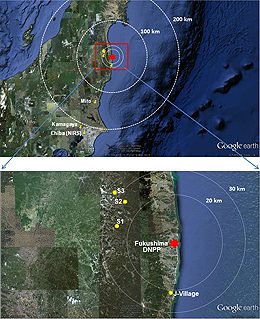Research Abstract
同位体比により明らかになった福島第一原子力発電所事故による環境中へのプルトニウム放出
Isotopic evidence of plutonium release into the environment from the Fukushima DNPP accident
2012年3月8日 Scientific Reports 2 : 304 doi: 10.1038/srep00304

福島第一原子力発電所(福島DNPP)事故は、環境への放射能の大量放出をもたらした。129mTe、131I、134Cs、136Cs、
137Csなどの揮発性の高い核分裂生成物が放出され、東日本の福島県とその隣県に広く分布していることはわかっている。しかし、不揮発性のアクチニド、特にPu同位体の放出については、事故後約1年たってもまだよくわかっていない。今回我々は、福島DNPPから20~30kmの地域の北西側と南側において、同位体比により明らかになったPuの大気放出と地表への降下について報告する。福島DNPP事故による高い241Pu/239+240Pu放射能比(>100)は、長期にわたる241Puの線量評価の必要性と241Amが徐々に増加することに注意を促すことになる。今回の結果は、原子炉損傷の評価に重要であり、除染の戦略に大きな影響を与える。ただし、プルトニウムの放出量を推定したところ、チェルノブイリのおよそ10,000分の1程度であった。
- 独立行政法人 放射線医学総合研究所
- 奥羽大学 生物学
The Fukushima Daiichi nuclear power plant (DNPP) accident caused massive releases of radioactivity into the environment. The released highly volatile fission products, such as 129mTe, 131I, 134Cs, 136Cs and 137Cs were found to be widely distributed in Fukushima and its adjacent prefectures in eastern Japan. However, the release of non-volatile actinides, in particular, Pu isotopes remains uncertain almost one year after the accident. Here we report the isotopic evidence for the release of Pu into the atmosphere and deposition on the ground in northwest and south of the Fukushima DNPP in the 20–30 km zones. The high activity ratio of 241Pu/239+240Pu (> 100) from the Fukushima DNPP accident highlights the need for long-term 241Pu dose assessment, and the ingrowth of 241Am. The results are important for the estimation of reactor damage and have significant implication in the strategy of decontamination.

